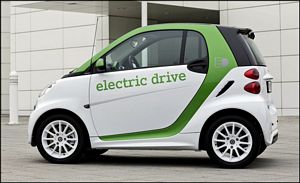|
By accessing/using The Crittenden Automotive Library/CarsAndRacingStuff.com, you signify your agreement with the Terms of Use on our Legal Information page. Our Privacy Policy is also available there. |

The Silent Revolution Is Silent No More
|
|---|
|
|
The Silent Revolution Is Silent No More
Geoff Maxted
DriveWrite
2 January 2014
Daimler / Mercedes-Benz usually go to great lengths to make engine noise less jarring and more auto-sexy. For their new electric models however, they’ve had to do the opposite by creating a suitable EV sound. For Daimler’s e-Smart city car, the company have invented a ‘sonorous purring’ that was pitched higher than conventional vehicles, whilst the Mercedes SLS AMG Coupe Electric Drive gets huskier tones to reflect its power.
“People expect some exterior noise from a vehicle, because we all grew up with the ‘vroom vroom’ of combustion engines,” the company have quite rightly said.
Daimler isn’t alone in adding noise to electric cars. Renault offers a choice of car tones - pure, glam and sport - on the excellent Zoë hatchback, while Nissan’s Leaf - the best-selling electric car - also comes with artificial sound. The issue has become more critical to manufacturers as regulators look to stick their beaks in and require warning noises as soon as next year. The production of more and more models forces manufacturers to seek ways to stand out from the silent crowd.
Synthetic motor noise, like the jangling, high-pitched whirr of Renault’s ‘glam’ track, could save lives and at the same time protect investments in electric cars. The vehicles emit almost no sound at low speeds, making them a potential silent threat for cyclists, pedestrians and other vulnerable groups used to reacting to the sound of engines. With electric cars already struggling to gain popularity, a spate of accidents could further dampen demand.
Although no data yet exists on injuries caused by electric vehicles, the European Union - on the basis that internal combustion cars knock down people anyway - takes the threat seriously enough to propose legislation making acoustic warning sounds mandatory.
Electric vehicles are mainly silent at speeds less than 20 miles per hour. Then tyre and wind noise kicks in. While adding motor sounds at slow speeds may help avoid accidents, it ironically also undercuts a unique selling point of electric vehicles. Because of this, some car makers are seeking to keep the din of electric vehicles to a minimum. BMW will add artificial sound to the i3 city car only where authorities demand it. Volkswagen AG also isn’t planning to add sound to its e-Up! model unless required.
Thankfully they have all discarded ideas of giving electric vehicles sounds such as birds twittering, leaves rustling or some jaunty melody or other. Shame. ‘Ride Of The Valkyries’ anyone?



















